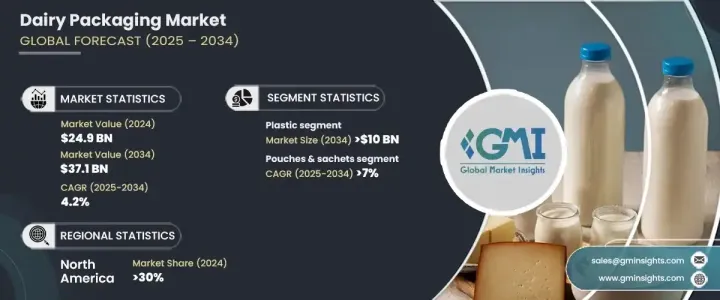
세계의 유제품 포장 시장은 2024년에 249억 달러로 평가되었으며, 2025년부터 2034년에 걸쳐 4.2%의 연평균 성장률(CAGR)로 성장할 것으로 예측됩니다.
이러한 성장은 환경 문제에 대한 인식이 높아지면서 친환경적이고 지속 가능한 포장 솔루션에 대한 소비자 수요가 증가함에 따라 크게 촉진되고 있습니다. 시장이 진화함에 따라 제조업체는 소비자의 변화하는 선호도를 충족하기 위해 혁신적인 디자인, 내구성 있는 소재, 기능적 편의성에 중점을 두고 있습니다. 급속한 도시화, 식습관의 변화, 편리한 이동식 유제품에 대한 선호로 인해 유제품 시장의 환경이 더욱 재편되고 있습니다. 또한 포장재와 생산 기술의 발전으로 가볍고 생분해성이며 재활용 가능한 옵션이 개발되면서 소비자 경험을 향상시킬 뿐만 아니라 지속 가능성 목표도 지원하고 있습니다. 이러한 혁신은 기업이 경쟁이 치열한 시장에서 돋보이는 동시에 타겟 고객의 환경 문제를 해결할 수 있도록 지원하고 있습니다.

재료별로는 플라스틱, 유리, 금속, 종이, 판지 등의 부문으로 나뉩니다. 플라스틱은 2034년까지 100억 달러에 달할 것으로 예상되는 등 유제품 패키징 시장을 계속 지배하고 있습니다. 플라스틱의 광범위한 인기는 탁월한 다용도성, 비용 효율성 및 생산 용이성 때문입니다. 특히 폴리에틸렌(PE) 및 폴리프로필렌(PP)과 같은 소재는 가벼운 특성, 내구성, 우수한 내습성으로 인해 높은 가치를 인정받고 있습니다. 이러한 특성은 유제품의 신선도 유지, 오염 방지, 유통기한 연장을 보장하며, 이는 오늘날 급변하는 소비자 시장에서 매우 중요한 요소입니다.
| 시장 범위 | |
|---|---|
| 시작 연도 | 2024년 |
| 예측 연도 | 2025-2034년 |
| 시작 금액 | 249억 달러 |
| 예측 금액 | 371억 달러 |
| CAGR | 4.2% |
특히 파우치 및 봉지 포장 유형은 편리성과 경제성, 휴대가 간편하고 1회 제공량을 원하는 소비자들에게 어필할 수 있는 장점으로 인해 높은 성장세를 보이고 있으며, 특히 파우치 및 봉지 포장의 인기가 높아지고 있습니다. 가볍고 공간 효율성이 뛰어난 이러한 형식은 우유, 요거트, 크림 등 다양한 유제품에 적합하며 다용도로 사용할 수 있습니다. 이러한 적응성은 이동 중인 제품에 대한 소비자 수요를 충족시킬 뿐만 아니라 바쁜 도시 인구의 라이프스타일 요구에도 부합합니다. 또한 파우치와 봉지는 취급이 간편하고 보관 효율이 높으며 제조업체에게 비용 효율적인 솔루션을 제공하므로 시장에서 더욱 각광받고 있습니다.
북미의 유제품 포장 시장은 미국의 강력한 수요에 힘입어 2024년에 30%의 점유율을 기록했습니다. 이 지역에서는 편의성과 지속 가능한 포장 솔루션에 대한 소비자 선호도가 높아지면서 업계 트렌드가 형성되고 있습니다. 파우치나 봉지에 포장된 제품 등 일회용 및 휴대용 유제품의 인기가 높아지는 것은 기능성과 편의성을 결합한 유연한 포장 형태로의 전환을 반영합니다. 또한, 환경적으로 책임감 있는 제품에 대한 관심이 높아지면서 제조업체들이 친환경 소재를 채택하게 되었고, 이는 소비자의 기대에 부응하고 브랜드 충성도를 강화하는 계기가 되었습니다. 이러한 추세는 향후 북미 유제품 포장 시장 전반에 걸쳐 혁신과 성장을 주도할 것으로 예상됩니다.
The Global Dairy Packaging Market, with its value reaching USD 24.9 billion in 2024, is projected to grow at a steady CAGR of 4.2% between 2025 and 2034. This growth is largely fueled by rising consumer demand for eco-friendly and sustainable packaging solutions, reflecting an increasing awareness of environmental concerns. As the market evolves, manufacturers are placing a strong emphasis on innovative designs, durable materials, and functional convenience to meet the changing preferences of consumers. The rapid urbanization, shifting dietary habits, and preference for convenient, on-the-go dairy products are further reshaping the landscape. Moreover, technological advancements in packaging materials and production techniques are driving the development of lightweight, biodegradable, and recyclable options, which not only enhance the consumer experience but also support sustainability goals. These innovations are empowering businesses to stand out in a highly competitive market while addressing the environmental concerns of their target audiences.

By material, the market includes segments such as plastic, glass, metal, paper, and paperboard, among others. Plastic continues to dominate the dairy packaging landscape, with projections estimating it will reach USD 10 billion by 2034. Its widespread popularity is attributed to its unmatched versatility, cost-effectiveness, and ease of production. Specifically, materials like polyethylene (PE) and polypropylene (PP) are highly valued for their lightweight properties, durability, and superior moisture resistance. These attributes ensure that dairy products maintain freshness, protection against contamination, and extended shelf life, which are critical factors in today's fast-paced consumer markets.
| Market Scope | |
|---|---|
| Start Year | 2024 |
| Forecast Year | 2025-2034 |
| Start Value | $24.9 Billion |
| Forecast Value | $37.1 Billion |
| CAGR | 4.2% |
The packaging type segment is witnessing robust growth, particularly for pouches and sachets, which have become increasingly popular due to their convenience, affordability, and appeal to consumers seeking portable and single-serve options. These lightweight, space-efficient formats are versatile and suitable for a wide array of dairy products, including milk, yogurt, and cream. Their adaptability not only caters to consumer demand for on-the-go products but also aligns with the lifestyle needs of busy, urban populations. Additionally, pouches and sachets offer easy handling, storage efficiency, and a cost-effective solution for manufacturers, further boosting their prominence in the market.
North America dairy packaging market captured a notable 30% share in 2024, driven by strong demand in the United States. In this region, growing consumer preferences for convenience and sustainable packaging solutions are shaping industry trends. The rising popularity of single-serve and portable dairy options, such as products packaged in pouches and sachets, reflects a shift toward flexible packaging formats that combine functionality with convenience. Additionally, the increasing focus on environmentally responsible products has prompted manufacturers to adopt eco-friendly materials, which resonates with consumer expectations and reinforces brand loyalty. This trend is expected to drive innovation and growth across the North American dairy packaging market in the coming years.